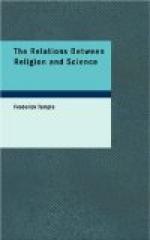He had to teach that the world as we see it, and all therein contained, was created out of nothing; and that the spiritual, and not the material, was the source of all existence. He had to teach that the creation was not merely orderly, but progressive; going from the formless to the formed; from the orderless to the ordered; from the inanimate to the animate; from the plant to the animal; from the lower animal to the higher; from the beast to the man; ending with the rest of the Sabbath, the type of the highest, the spiritual, life. Nothing, certainly, could more exactly match the doctrine of Evolution than this. It is, in fact, the same thing said from a different point of view. All this is done by casting the account into the form of a week of work with the Sabbath at the end. In so constructing his account, the writer made use of a mode of teaching used commonly enough in the Bible. The symbolical use of the number seven is common in other inspired writers. The symbolical use of periods of time is not without example. That the purpose of the account was not to teach great truths, but to give men information upon scientific questions, is incredible. And, in fact, if we look in this account for literal history, it becomes very difficult to give any meaning to what is said of the seventh day, or to reconcile the interpretation of it with our Lord’s words concerning the Sabbath, ‘My Father worketh hitherto, and I work.’ There is no more reason for setting aside Geology, because it does not agree in detail with Genesis, than there is for setting aside Astronomy because all through the Old Testament the sun is spoken of as going round the earth.
And when the writer of Genesis passes from creation in general to man in particular, it is still clear that he has no mission to tell those for whom he was writing by what processes man was formed, or how long those processes lasted. This was as alien from his purpose as it would have been to tell what every physiologist now knows of the processes by which every individual man is developed from a small germ to a breathing and living infant. He takes men—and he could not but take men as he sees them—with their sinful nature, with their moral and spiritual capacity, with their relations of sex, with their relations of family. He has to teach the essential supremacy of man among creatures, the subordination in position but equality in nature of woman to man, the original declension of man’s will from the divine path, the dim and distant but sure hope of man’s restoration. These are not, and cannot be, lessons of science. They are worked out into the allegory of the Garden of Eden. But in this allegory there is nothing whatever that crosses the path of science, nor is it for reasons of science that so many great Christian thinkers from the earliest age of the Church downwards have pronounced it an allegory. The spiritual truth contained in it is certainly the purpose for which it is told; and evolution such as science has rendered probable had done its work in forming man such as he is before the narrative begins.




